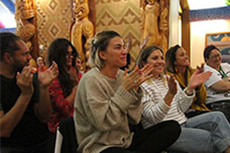Indigenous storytelling and the screen

Indigenous storytellers gathered at AUT for the Ngā Aho Whakaari (Māori in Screen Production) Hui ā Tau – a weekend for industry, scholars and students to share knowledge.
Interactive sessions from some industry heavyweights, held across two days on Ngā Wai o Horotiu Marae at City Campus, yielded fruitful discussions on digital technology, delivering to different platforms, marketing indigenous voices to the world and the vitalisation of te reo Māori.
Steve Barr worked in the Hollywood system for 16 years before moving to New Zealand. His many varied roles included a stint as a corporate suit for NBC Universal and VP Development at SMASHfilms, in addition to working as a screenwriter and independent producer.
Speaking to an audience of writers, producers and directors on the art of pitching, Barr noted that ‘in an era where film has never been easier or cheaper to produce, the real challenge is getting your work out there’.
“Pitching your project is not a performance, it’s a conversation,” he says.
“It’s like being on a first date. Everyone is on their best behaviour. So, if you feel there is something uncomfortable, even weird, about the vibe from the person you’re pitching to, then recognise that you are never going to work with that person.”
Participants had the opportunity to pitch for funding for a short film and TV series, supported by the New Zealand Film Commission and Te Māngai Pāho respectively.
The hui ā tau included a Māori & Indigenous Screen Colloquium, convened by Dr Ella Henry and Christina Milligan at AUT, for emerging scholars and established academics alike to share their research and creative outputs.
Dr Henry, a senior lecturer at Te Ara Poutama, the Faculty for Māori & Indigenous Development, has a long association with Māori film and television. Her PhD focused on Māori entrepreneurship in screen production and she previously served as chair of Ngā Aho Whakaari.
“Māori have been instrumental in the creation of New Zealand’s highest grossing films, including Hunt for the Wilderpeople, Mahana, The Dead Lands, The Dark Horse, Boy and Once Were Warriors,” she says.
Dr Henry points to the creation of the Māori Television Service as a pivotal development. Launched in 2003, the state sector organisation has seen thousands of hours of Māori-centric programming developed in te reo and English.
“This combination of Māori storytelling in film and broadcasting has transformed New Zealand’s screen industry and empowered a new generation of Māori, confident in te reo and tikanga Māori, to achieve in all areas of production,” she says.
Christina Asher, chair of Ngā Aho Whakaari, says many Māori work in screen production.
“We’re good at the mahi and the awhi, but now it’s our job to get more Māori into career roles at the top of the ladder,” she says.
Taika Waititi is just one example of Māori who are achieving internationally.
AUT graduates include Chelsea Winstanley, who produced Hunt for the Wilderpeople, and Toiroa Williams, who is currently working at the Sundance Institute in Los Angeles as part of the AUT talenthub Programme.
“Education is the first step in maintaining a cohort of Māori storytellers who can excel nationally and internationally,” says Dr Henry.